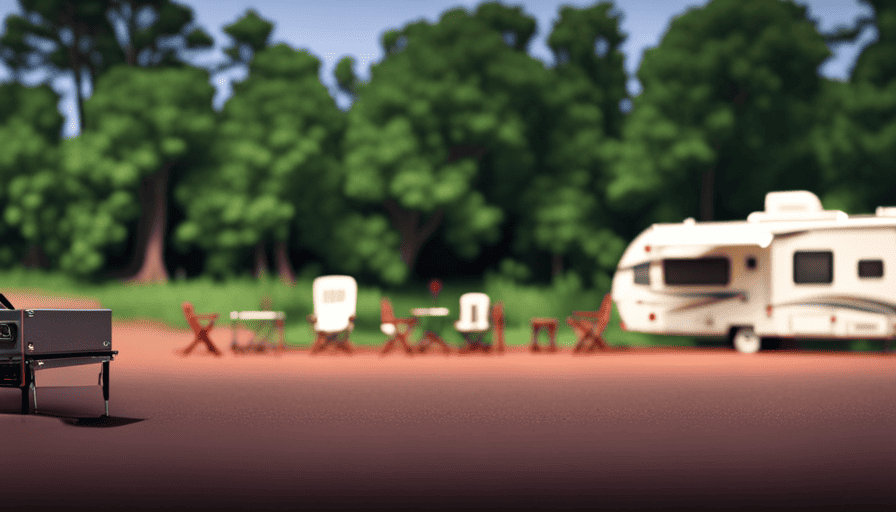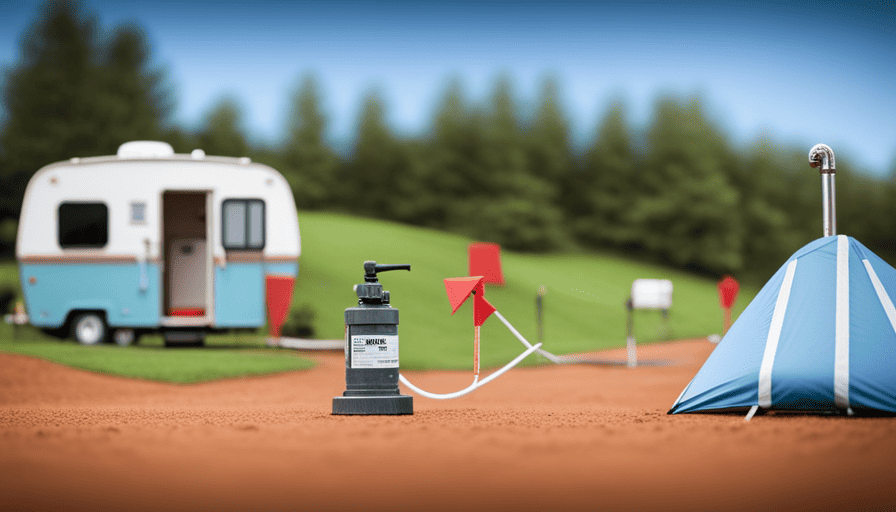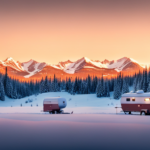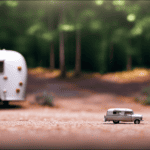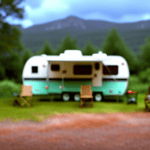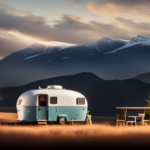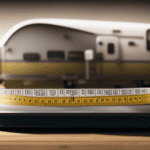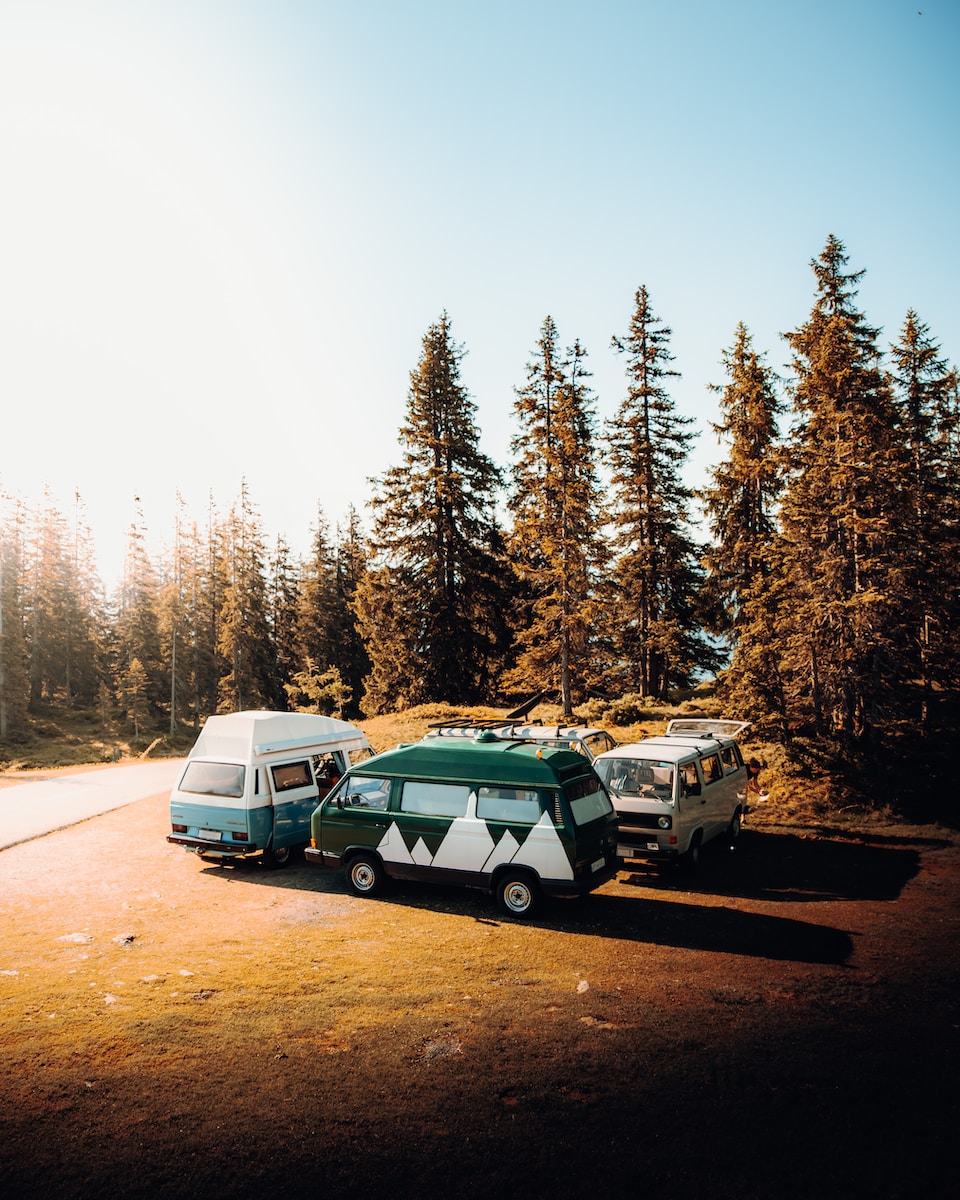The adage, ‘Home is where you park it,’ couldn’t hold more truth. What superior method is there to enjoy the wonders of nature than by establishing your camper trailer? No matter if you’re an experienced voyager or a novice, the task of assembling a camper trailer might appear overwhelming. However, worry not! We are here to lead you through the procedure of crafting your own comfortable haven on the road.
In this article, we’ll walk you through everything you need to know to set up your camper trailer like a pro. From choosing the perfect campsite to organizing your interior space, we’ll provide you with practical tips and detailed instructions to ensure a smooth and enjoyable camping adventure.
So, grab your toolkit and let’s get started! Together, we’ll learn how to level and stabilize your camper, connect utilities and hook up to power, set up the exterior amenities, and create a comfortable outdoor living space. We’ll also share essential tips on stocking up supplies and organizing your kitchen and dining area.
Get ready to embark on an unforgettable camping journey. It’s time to set up your camper trailer and embrace the freedom of the open road!
Key Takeaways
- Choose the perfect campsite based on location, amenities, size, and environment.
- Level and stabilize the camper using blocks, ramps, and stabilizing jacks.
- Connect utilities like water, sewer, and electricity.
- Create a comfortable and inviting living space with both interior and exterior amenities.
Choose the Perfect Campsite
Finding the ideal campsite for our camper trailer can make or break our outdoor adventure! When it comes to finding the best campgrounds, there are a few key factors to consider.
First and foremost, location is crucial. We want to choose a campsite that is not only beautiful but also conveniently located near the activities and attractions we plan to enjoy.
Next, we need to think about the amenities offered at the campground. Are there clean restrooms, showers, and laundry facilities? Is there a camp store or a nearby grocery store for any last-minute supplies?
Additionally, we should consider the size and layout of the campsite. Is it spacious enough to accommodate our camper trailer? Does it have a level surface?
Lastly, we want to be mindful of the surrounding environment. Are there any potential hazards such as falling branches or flooding areas? Taking the time to carefully evaluate these factors will ensure that we find the perfect campsite for our camper trailer.
Now, let’s move on to the next step: leveling and stabilizing our camper.
Level and Stabilize Your Camper
To ensure a stable and level camper, you’ll want to begin by parking on a flat surface. This will make the leveling process much easier. Once you’ve found a suitable spot, it’s time to level and stabilize your camper.
Here are some leveling tips and stabilizing techniques to help you get started.
First, make sure to use leveling blocks or ramps to raise the low side of your camper. These blocks can be stacked or placed underneath the wheels to achieve a level position. It’s important to check the level of your camper using a bubble level or an app on your smartphone. Adjust the blocks or ramps as needed until your camper is perfectly level.
Next, use stabilizing jacks to prevent any movement or shaking once your camper is level. These jacks are typically located at each corner of the camper and can be extended to the ground. By tightening them, you’ll create a stable and secure foundation for your camper.
In addition to leveling and stabilizing, it’s also important to chock the wheels of your camper. This will prevent any rolling or shifting while you’re inside. Simply place wheel chocks on both sides of each wheel and make sure they are securely in place.
With your camper now level and stable, you’re ready to move on to the next step: connecting utilities and hooking up to power. This will ensure that you have all the necessary amenities for a comfortable camping experience.
Connect Utilities and Hook Up to Power
Now that your camper is level and stable, it’s time to get connected and powered up for a comfortable camping experience!
One of the first things you’ll want to do is connect your utilities. Depending on the campground you’re staying at, you may have access to water, sewer, and electricity hookups. Locate the utility connections on the outside of your camper and connect the appropriate hoses and cables. Make sure to tighten the connections securely to avoid any leaks or power interruptions.
Next, it’s important to hook up to a power source. Most campgrounds provide electrical hookups, typically with 30 or 50 amp service. Begin by switching off the circuit breaker in your camper’s electrical panel. Then, plug your power cord into the campground’s electrical pedestal and switch the breaker back on. This will supply power to your camper’s electrical system, allowing you to use appliances, lights, and charge your devices.
With your utilities and power connected, you’re ready to set up the exterior amenities. This includes things like awnings, outdoor furniture, and grills. These amenities will enhance your camping experience and provide a comfortable outdoor living space.
Set Up the Exterior Amenities
Once your camper is connected and powered up, it’s time to create a cozy outdoor living space with awnings, furniture, and grills. Here are three essential steps to set up the exterior amenities:
-
Install an awning: An awning provides shade and protection from the elements. It’s easy to set up by extending the arms and securing them in place. Make sure to position it correctly to block the sun during the hottest parts of the day.
-
Arrange outdoor furniture: Transform your campsite into a comfortable oasis by placing outdoor chairs, tables, and loungers. Consider the size of your camper and the available space before selecting furniture. Opt for lightweight and foldable pieces that are easy to transport and store.
-
Set up an outdoor cooking area: Outdoor cooking is a staple of camper living. Set up a portable grill or stove to prepare delicious meals. Ensure you have a sturdy table or countertop to place your cooking equipment. Don’t forget to bring cooking utensils, pots, pans, and plates for a complete outdoor dining experience.
With your exterior amenities in place, it’s time to organize your interior space for maximum comfort and functionality.
Organize Your Interior Space
Create a cozy and functional interior space by arranging furniture, organizing storage compartments, and adding personal touches to make it feel like home.
When setting up your camper trailer, it’s important to maximize storage and create a functional layout to make the most of the limited space. Start by assessing the available storage compartments and use them wisely. Install shelves, hooks, and organizers to keep your belongings tidy and easily accessible. Utilize under-bed storage bins and wall-mounted baskets to make the most of vertical space.
Next, arrange your furniture strategically to create an open and inviting atmosphere. Place the dining table and chairs near the kitchen for convenience, and position the seating area near the windows to enjoy the view. Consider using multipurpose furniture, such as a sofa bed or ottoman with built-in storage, to save space.
To add a personal touch, decorate the interior with your favorite items. Hang artwork, display family photos, and incorporate decorative pillows and throws to make it feel cozy. Don’t forget to include practical items like a first aid kit, fire extinguisher, and tool kit for emergencies.
By maximizing storage, creating a functional layout, and adding personal touches, you can transform your camper trailer into a comfortable and inviting home away from home. Transitioning into the subsequent section about creating a cozy sleeping area, focus on the importance of a comfortable mattress and bedding.
Create a Cozy Sleeping Area
Ensure you have a comfortable and inviting sleeping area in your cozy home away from home by investing in a plush mattress and soft bedding. When it comes to setting up a camper trailer, creating a cozy sleeping area is essential for a restful night’s sleep.
To maximize storage, consider choosing a mattress that comes with built-in drawers or compartments underneath. This way, you can easily store extra bedding, pillows, and other essentials. Additionally, opt for bedding that is not only comfortable but also space-saving. Look for bedding sets that come with fitted sheets, duvet covers, and pillowcases that can be easily rolled up and stored when not in use. This will help you save precious space in your camper trailer.
When choosing the right bedding, prioritize comfort and quality. Invest in a mattress that offers good support and is made from durable materials. Consider adding a mattress topper for extra cushioning and warmth. For bedding, opt for soft, breathable fabrics that’ll keep you cozy without causing you to overheat. Look for lightweight blankets and hypoallergenic pillows to ensure a peaceful night’s sleep.
Now that you’ve created a cozy sleeping area, it’s time to set up your kitchen and dining area.
Set Up Your Kitchen and Dining Area
Now that we’ve created a cozy sleeping area in our camper trailer, let’s move on to setting up the kitchen and dining area. This is an essential part of our camper setup because it allows us to prepare meals and enjoy them comfortably.
To maximize storage in the kitchen area, consider installing shelves or hanging organizers on the walls. This’ll help you keep your cooking utensils, pots, and pans neatly organized and easily accessible. Another great storage solution is using stackable containers for storing dry food items.
When it comes to meal preparation, having a portable stove or a camping grill is a must. These compact cooking appliances allow you to cook delicious meals while on the go. Don’t forget to pack essential kitchen tools like a cutting board, knives, and a set of cookware.
In addition to the kitchen setup, creating a dining area is equally important. Set up a folding table and chairs to enjoy your meals comfortably. You can also add a tablecloth and some decorations to make it feel more inviting.
With our kitchen and dining area all set up, we’re now ready to move on to creating a comfortable outdoor living space.
Create a Comfortable Outdoor Living Space
Transform your outdoor area into a cozy oasis where you can relax, unwind, and enjoy the beauty of nature. When it comes to creating a comfortable outdoor living space in your camper trailer, there are a few key elements to consider.
First, let’s talk about outdoor furniture options. Space is often limited in a camper trailer, so choosing furniture that’s compact and multi-functional is essential. Look for foldable chairs and tables that can easily be stored when not in use. Additionally, consider investing in outdoor cushions and pillows to add an extra layer of comfort to your seating area.
Next, let’s discuss lighting and decor ideas. String lights are a great way to create a warm and inviting atmosphere in your outdoor space. Hang them around your awning or attach them to nearby trees for a magical ambiance. Lanterns and solar-powered lights are also practical options for illuminating your outdoor area during nighttime. To add a personal touch, consider incorporating outdoor rugs, throw blankets, and decorative plants to make your space feel like home.
As you start to create your outdoor living space, don’t forget to stock up on supplies and essentials for your camper trailer adventure.
Stock Up on Supplies and Essentials
Don’t forget to gather all the necessary supplies and essentials for your camper trailer adventure, such as food, water, and camping gear. Did you know that according to a recent survey, the average camper spends around $500 on supplies for their camping trip?
To ensure a comfortable and enjoyable outdoor living space, it’s important to stock up on essential camping gear. This includes a sturdy tent, sleeping bags, camping chairs, and a portable camping stove. These items will provide you with the basic necessities for a comfortable stay in your camper trailer.
In addition to camping gear, proper meal planning and cooking tips are essential for a successful camping trip. Before you hit the road, plan your meals in advance and make a detailed shopping list. Consider easy-to-cook meals that require minimal preparation and cleanup. Don’t forget to pack non-perishable food items such as canned goods, granola bars, and snacks for quick and convenient meals on the go.
As you gather your supplies and plan your meals, remember to also pack plenty of water for drinking, cooking, and cleaning. Staying hydrated is crucial during outdoor activities, so make sure to have enough water for your entire trip.
Now that you’ve stocked up on supplies and essentials, it’s time to enjoy your camping adventure! Whether you’re hiking, fishing, or simply relaxing by the campfire, make the most of your time in nature and create lasting memories.
Enjoy Your Camping Adventure!
Get ready to have an incredible time on your camping adventure! Now that you’ve stocked up on all the necessary supplies and essentials, it’s time to hit the road and enjoy the great outdoors.
But before you go, let’s discuss some tips for packing efficiently and important safety precautions to keep in mind while camping.
When it comes to packing efficiently, it’s important to prioritize the items you’ll need the most. Start by packing your camping gear such as tents, sleeping bags, and cooking equipment. Next, pack your clothing and personal items, making sure to bring enough layers for various weather conditions. Remember to pack food and water, but be mindful of weight restrictions and perishable items.
Safety should always be a top priority while camping. Make sure to check the weather forecast before heading out and be prepared for any changes in conditions. Familiarize yourself with the campground rules and regulations, and always follow fire safety guidelines. It’s also a good idea to bring a first aid kit and know how to use it.
With these tips for packing efficiently and safety precautions in mind, you’re all set to embark on your camping adventure. Enjoy the fresh air, stunning scenery, and quality time spent with loved ones. Happy camping!
Frequently Asked Questions
How do I properly maintain and clean my camper trailer?
Maintaining and cleaning our camper trailer is essential for its longevity and our comfort. Regularly inspecting the exterior for any damage, such as cracks or leaks, is a good starting point.
Cleaning the trailer involves removing dirt and grime using a mild detergent and a soft brush. Don’t forget to clean the interior as well, including the floors, countertops, and bathroom.
Regularly emptying and cleaning the holding tanks is also crucial. By following these steps, we can ensure our camper trailer stays in great condition for many adventures to come.
What are some essential safety precautions to take while camping with a camper trailer?
When camping with a camper trailer, safety should be our top priority. Before embarking on our adventure, it’s crucial to take essential precautions to ensure a smooth and secure trip.
Familiarize ourselves with safety procedures, inspecting the trailer for any potential hazards, and learning how to handle common electrical issues are all important steps. By doing so, we can fully enjoy our camping experience, knowing we’ve taken the necessary steps to keep ourselves and our loved ones safe.
How do I troubleshoot common issues with the camper trailer’s electrical system?
When troubleshooting common camper trailer electrical problems, there are a few steps you can take.
First, check the main power source and make sure it’s connected properly.
Next, inspect the fuses and circuit breakers to see if any have blown or tripped.
If everything seems to be in order, test the battery and connections for any issues.
If there is a malfunctioning appliance, check the wiring and connections.
If the problem persists, it may be best to consult a professional for further assistance.
Are there any tips for maximizing storage space in a camper trailer?
When it comes to maximizing storage space in a camper trailer, organization is key. By cleverly arranging your belongings, you can transform even the tiniest nooks and crannies into valuable storage areas.
Utilize hanging organizers, collapsible bins, and storage bags to keep items neatly in place. Don’t forget to make use of vertical space by installing shelves or hooks. With a little creativity and some handy organization tips, you’ll be amazed at how much you can fit into your camper trailer.
What are some recommended resources or websites for finding the best campsites for camper trailers?
When looking for the best campsites for camper trailers, there are a few resources and websites that can be really helpful.
One of my favorites is Campendium, which provides a comprehensive list of campsites across the country, complete with reviews and photos.
Another great option is ReserveAmerica, where you can search for campsites based on location, amenities, and availability.
Additionally, websites like RV Park Reviews and TripAdvisor offer valuable insights from fellow campers.
Remember to check for tips on leveling your camper trailer to ensure a comfortable stay.
What Are the Steps to Set Up a Camper Trailer for Living In?
Setting up a camper for living involves a few important steps. First, find a suitable location and park the trailer. Once parked, level the camper using jacks or blocks. Next, connect the utility hookups for water, electricity, and sewage. Set up the awning and outdoor furniture to create an inviting living space. Finally, make sure all systems, such as heating, cooking, and plumbing, are operational before settling in.
Conclusion
Well, there you have it folks! We’ve successfully set up our camper trailer and we’re ready to embark on a camping adventure like no other.
With our perfect campsite, leveled and stabilized camper, connected utilities, and hooked up to power, we’re all set to enjoy the great outdoors.
Don’t forget to set up your exterior amenities, organize your interior space, and create a comfortable outdoor living area. And of course, stock up on supplies and essentials to ensure a smooth and enjoyable trip.
So go ahead, hit the road, and let the camping fun begin!

